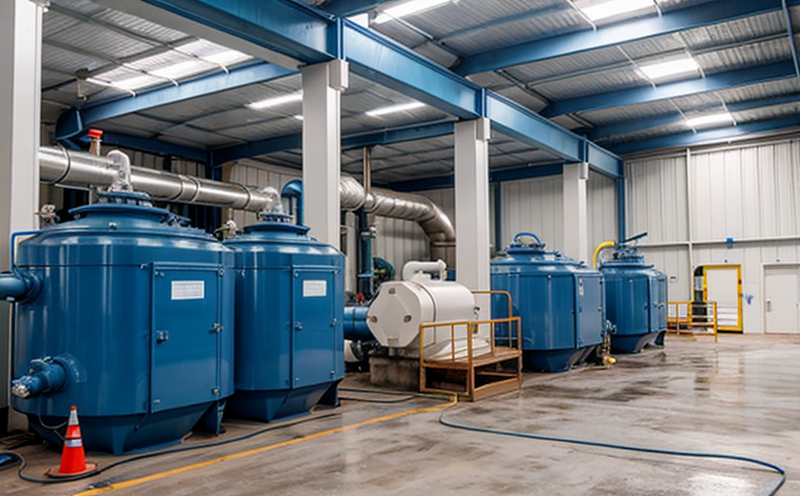EPA Method 625 Semi-Volatile Organics Testing in Wastewater
The EPA Method 625 semi-volatile organic compounds (SVOCs) testing procedure is a critical tool for environmental compliance and the quality control of wastewater treatment systems, particularly in sectors like marine and ship equipment. This method provides a standardized approach to detecting SVOCs that are present at low concentrations in complex matrices such as ballast water and other types of industrial or municipal wastewaters.
SVOCs encompass a wide range of compounds including polycyclic aromatic hydrocarbons (PAHs), pesticides, herbicides, and flame retardants. These pollutants can pose significant risks to aquatic ecosystems if not properly treated before discharge into natural water bodies. Compliance with regulatory standards like the U.S. Environmental Protection Agency's (EPA) regulations is essential for maintaining environmental responsibility.
The testing process under EPA Method 625 involves several key steps: sample collection, extraction, derivatization, and analysis using gas chromatography/mass spectrometry (GC/MS). Each of these stages requires precise handling to ensure accurate results. Sample preparation begins with the collection of representative wastewater samples from various points within a facility or vessel. Proper sampling techniques are crucial as they directly impact the reliability of subsequent analyses.
Once collected, samples undergo extraction using either solvent-based methods (such as liquid-liquid extraction) or solid-phase microextraction (SPME). Derivatization may be necessary to enhance detection sensitivity during the GC/MS analysis. After extraction and derivatization, the compounds are separated by gas chromatography before being identified through mass spectrometry. This separation allows for qualitative and quantitative determination of SVOCs present in the sample.
Compliance with EPA Method 625 ensures that facilities handling ballast water or other forms of industrial wastewater can demonstrate adherence to stringent environmental guidelines set forth by regulatory bodies such as the International Maritime Organization (IMO) under its Ballast Water Management Convention. Proper implementation of this method helps minimize ecological impacts while also supporting sustainable practices in maritime operations.
Understanding and applying EPA Method 625 correctly is vital for maintaining compliance with relevant regulations and ensuring safe operation of wastewater treatment processes. By leveraging advanced analytical techniques like GC/MS, laboratories can achieve highly accurate measurements necessary to meet stringent regulatory requirements.
- International Acceptance: This method has been widely accepted globally due to its robustness and reliability in detecting SVOCs. Many countries use or reference EPA Method 625 when establishing their own testing protocols.
In summary, the successful application of EPA Method 625 is essential for ensuring accurate identification and quantification of semi-volatile organic compounds in wastewater samples, thereby supporting compliance efforts aimed at protecting aquatic environments from potential harm caused by these pollutants.
Applied Standards
EPA Method 625 aligns closely with broader environmental protection initiatives such as the Clean Water Act (CWA) and International Maritime Organization's Ballast Water Management Convention. The CWA mandates strict limits on pollutant discharges into U.S. waters, including those associated with ballast water from ships. Similarly, the IMO convention aims to reduce the spread of harmful organisms through regulated ballast water exchanges.
The EPA’s development and endorsement of Method 625 reflect its commitment to developing robust analytical tools capable of identifying even trace levels of SVOCs relevant to both terrestrial and aquatic ecosystems. By adhering to these standards, laboratories ensure that their testing practices are consistent with international best practices, enhancing confidence in the results produced.
Furthermore, compliance with EPA Method 625 supports broader sustainability goals by promoting efficient resource use and minimizing adverse impacts on local waterways. This aligns with broader trends toward greener operations within industries operating near sensitive coastal areas or those involved in global maritime transportation networks.
Our laboratory offers comprehensive services tailored specifically towards EPA Method 625 compliance, leveraging state-of-the-art equipment and experienced personnel. We understand the importance of accurate SVOC detection for maintaining environmental integrity across diverse applications ranging from shipyards to industrial facilities.
At Eurolab, we provide a full suite of analytical support including sample preparation, extraction optimization, derivatization assistance, and final GC/MS analysis. Our dedicated team ensures that every step adheres strictly to EPA Method 625 guidelines, ensuring reliable results that meet stringent regulatory requirements.
We also offer tailored consultation services designed specifically for our clients looking to optimize their testing procedures or navigate complex compliance challenges. By working closely with your organization, we can help identify areas where improvements are needed and implement solutions that enhance both efficiency and accuracy in your testing processes.
Our commitment extends beyond just meeting current standards; Eurolab continuously invests in research and development to stay at the forefront of technological advancements within our field. This ensures that you receive cutting-edge tools and methodologies, giving you a competitive edge in maintaining compliance with evolving regulations.





